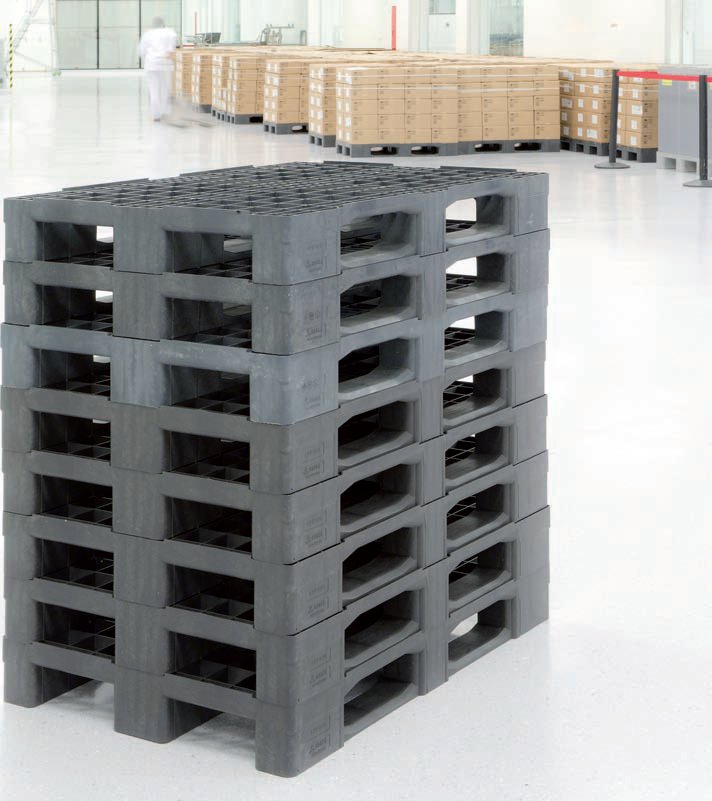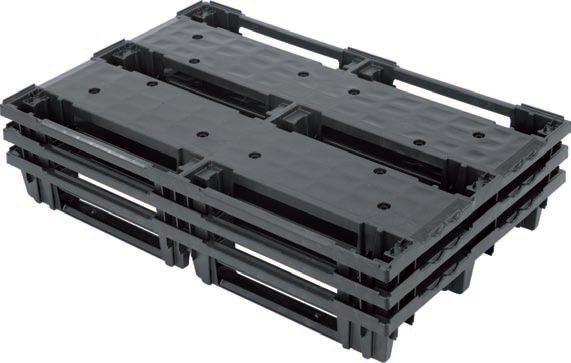Growth and innovation in plastic pallets
21 June 2013As part of our Around The Warehouse feature, Hoist looks at the development of the pallet and the growing market for plastic pallets.
For hundreds of years the pallet has been a familiar feature in warehouses all over the world. According to historians, pallet-like structures have been used as bases for at least a few hundred years for applications such as the safe stacking and stabilization of kegs.
The story of the pallet's evolution over the years is one of a dynamic, stop start process that is still underway to this very day.
Initially, spacers were used between loads to allow fork placement and withdrawal, progressing to the placement of boards atop stringers to make skids. This facilitated the stacking of a greater range of loads. Eventually boards were fastened to the bottom to create the modern pallet. The modern day pallet was beginning to take shape.
The development of the pallet eliminated the potentially unsafe and time consuming practice of the operator frequently climbing out on the front of the lift truck to place the 2x4s between unit loads, while reducing the risk of stringer collapse.
The development of the bottom deck benefited the unit load base in a number of ways, including better distribution of weight over the load below, as well as less risk of pallet stringer collapse.
Pallet development further evolved with the introduction of 4-way entry and alternative material pallets in the 1940s. During World War 2, the use of the pallet and forklift would become a key component of the U.S. military logistics strategy.
According to Cleveland-based industry market research firm, The Freedonia Group, U.S. demand for pallets is forecast to rise 6.1 percent per year to 1.3 billion units in 2015, valued at $15 billion. The increase will be driven by a rebound in manufacturing output.
This pace will represent a dramatic turnaround from the 2005-2010 period, when demand fell to fewer than one billion pallets in response to a decline in manufacturing output between 2007 and 2009 and a partial rebound in 2010. Through 2015, demand gains will be driven by an expected advance in manufacturing from the low 2010 base.
Around The Warehouses examines one growing sector of the pallet industry: the market for plastic pallets.
Jim Hardisty, Managing Director of Goplasticpallets.com, said that, despite the economic uncertainty of recent years, overall demand for plastic pallets remains relatively unaffected.
In fact, Goplasticpallets.com has experienced an uptick in sales. Hardisty described the increase in demand as being the result of more businesses recognising the benefits of using plastic, in comparison to the historic wooden pallet.
"That's not to say we've been untouched by the recent economic uncertainty," he added.
"The dip in UK exports has had an impact on our export pallet sales, where we have experienced peaks and troughs. However with the Government recently awarding £13million funding to help British firms boost their export activities to double UK exports to £1trillion by 2020, we're hopeful this will help drive up our export pallet sales." Innovations in plastic pallets over the last 10 years have seen a greater than ever variety of materials, sizes, styles and specifications introduced to the market. This includes hygienic pallets with smooth, easy clean surfaces suitable for the food and pharmaceutical industries; lightweight, low cost pallets exempt from ISPM15 Wood Packaging Regulations and therefore ideal for export; and large pallet boxes perfect for the storage and disposal of waste.
Hardisty noted that another development that has played an important role in the evolution of the plastic pallet is the environmental credentials of plastic pallets.
He said: "Many of our pallets are available manufactured from recycled materials and are also recyclable - so at the end of their working life the plastic can be reground to produce other plastic products."
Looking to the future, pallet manufacturers around the world are cautuously optimistic. Many are anticipating that the trend of modern production techniques producing stronger, higher performance pallets from less material - and therefore at a lower weight and price bracket - will continue.
The same has been said of developments in recycled materials; as recycling targets worldwide continue to rise year on year, many anticipate greater opportunities to mix lower value material with existing engineered polymers which will, ultimately, lower the pallet cost. And it is companies like Goplasticpallets.com that are helping drive the industry forward.
Hardisty said: "Close partnerships with a number of manufacturing factories in Europe means that we can not only offer the widest range of plastic pallets available in the UK, but we're able to cater for all types of bespoke design and customisation specifications, since we have immediate access to the most sophisticated software and CAD equipment.
"We're also constantly feeding back useful information from meetings with current and prospective clients to the factories, so they can see the demand for new sizes and specifications - feedback from the end user is hugely valuable.
Meetings we have with major retailers where their potential pallet requirement could be in the millions, are such a good source of future product developments. "As they plan five years ahead, we're understanding what the market will require in five years' time and can work towards it."
With many companies slowly shaking off the lethargy of recent years Jim Hardisty points to the companies' expansion as its most notable achievement of recent years. He told Hoist: "Our growth - even during uncertain economic times - is our greatest achievement, and we feel this is a result of our investment not only in our product range, but our sales team. Between us, our sales team of seven share more than 100 years' experience in plastics!
We have also been successful securing exclusive pallet distribution rights with a number of pallet manufacturers in Europe including CABKA-IPS and SmartFlow in Belgium and Q-Pall in the Netherlands." Hardisty said: "Now is an exciting time for Goplasticpallets.com.
"We've just increased the size of our sales force and will soon be moving to new offices, and we've also increased our pallet stock with 31 new additions, which means we can now supply more than 155 different plastic pallets and 115 plastic containers."
Hardisty added: Over the next few months, we'll be launching the 31 plastic pallets which make up our new CABKA-IPS range."



